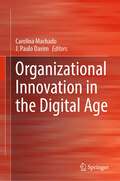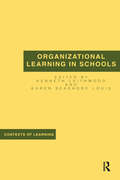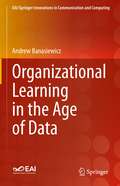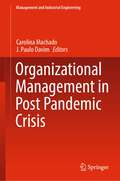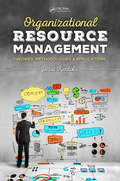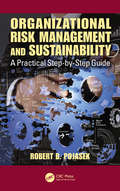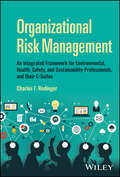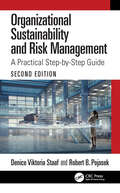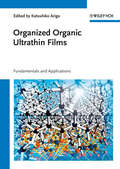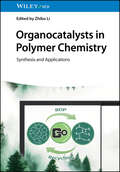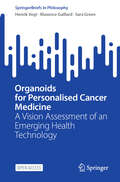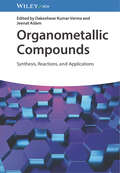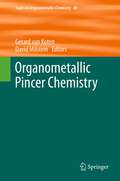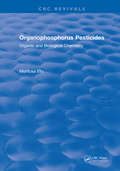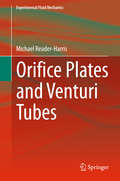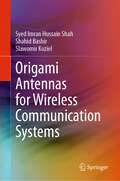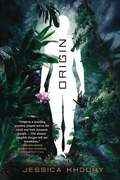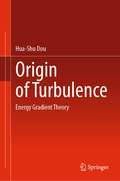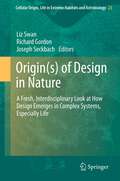- Table View
- List View
Organizational Innovation in the Digital Age
by J. Paulo Davim Carolina MachadoThis book focuses on how businesses manage organizational innovation processes. It explores the innovative policies and practices that organizations need to develop to allow them to be successful in this digital age. These policies will be based on key resources such as research and development and human resources and need to enable companies to respond to challenges they may face due to the digital economy. It explains how organizational innovation can be used to improve business’s development, performance, conduct and outcomes. Contributing to stimulate the growth and development of each individual in a dynamic, competitive and global economy, the present book can be used by a diverse range of readers, including academics, researchers, managers and engineers interested in matters related with Organizational Innovation in the Digital Age.
Organizational Learning in Schools
by Kenneth Leithwood and Karen Seashore LouisThis volume presents the view that what matters most are learning processes in organizations and ways of enhancing the sophistication and power of these processes. Each contributor, therefore, explicitly addresses the meaning(s) of organizational learning which they have adopted themselves.
Organizational Learning in the Age of Data (EAI/Springer Innovations in Communication and Computing)
by Andrew BanasiewiczThis book discusses the impact of advanced information technologies, such as data processing, machine learning, and artificial intelligence, on organizational decision-making processes and practices. One of the book’s central themes is the interplay between human reasoning and machine logic in the context of organizational functioning, specifically, the fairly common situations in which subjective beliefs are pitted against objective evidence giving rise to conflict rather than enhancing the quality of organizational sensemaking. Aiming to not only raise the awareness of the potential challenges but also to offer solutions, the book delineates and discusses the core impediments to effective human-information technology interactions, and outlines strategies for overcoming those obstacles on the way to enhancing the efficacy of organizational decision-making.
Organizational Management in Post Pandemic Crisis (Management and Industrial Engineering)
by J. Paulo Davim Carolina MachadoThis book presents the tools and policies necessary to undertake with success post-pandemic crisis. The chapters focus on topics of interest such as the challenges in economic and business sectors around the world, economic and business recession, unemployment, increased market uncertainty, more demanding suppliers and costumer orders, production interruptions, internal organizational and structural demands, among others.
Organizational Resource Management: Theories, Methodologies, and Applications
by Jussi KantolaThe management of organizational resources is extremely difficult. Managers face serious and complex challenges when managing the required resources for the benefit of their organization. This book presents a unique approach that aims to tackle these management challenges. This approach is based on four propositions that together form a solid frame
Organizational Risk Management and Sustainability: A Practical Step-by-Step Guide
by Robert B. PojasekThis book offers a practical and reliable approach to how an organization can move beyond all of the separate initiatives and hype associated with sustainability. It shows how to build in what is already in place, in order to create a sense of stewardship that protects the environment, creates a sense of social well-being, and shared value within the organization.
Organizational Risk Management: An Integrated Framework for Environmental, Health, Safety, and Sustainability Professionals, and their C-Suites
by Charles F. Redinger“Dr. Redinger provides a framework for dealing with integrated risk as well as the processes and tools to help and guide your successful strategy. If risk management is important to you, then I would recommend this book.”—Malcolm Staves, Global Vice President Health & Safety, L’Oréal “Dr. Redinger’s framing within a risk management context provides a vital contribution to public policy and organizational governance now and in the future. The book’s Risk Matrix is a brilliant effort in evolving how we can see and work with the diversity of impact-dependency pathways between an organization, and human, social, and natural capitals. A must-read for the risk professionals ready to shape the future.”—Natalie Nicholles, Executive Director, Capitals Coalition A hands-on roadmap to creating a risk management platform that integrates leading standards, improves decision-making, and increases organizational resilience Organizational Risk Management delivers an incisive and practical method for the development, implementation, and maintenance of an integrated risk management system (RMS) that is integrated with ISO 31000:2018, ISO’s high-level management system structure (HLS), and COSO’s ERM. The book explains how organizational risk management offers a platform and process through which organizational values and culture can be evaluated and reevaluated, which encourages positive organizational change, value creation, and increases in resilience and fulfilment. Readers will find an approach to risk management that involves the latest advances in cognitive and organizational science, as well as institutional theory, and that generates a culture of health and learning. The book also offers: Thorough discussions of the social aspects of organizational risk management, with links to evolving Environmental, Social, and Governance norms and practices Detailed frameworks and systems for the measurement and management of risk management Insightful explanations of industry standards, including COSO’s ERM and ISO’s risk management standards Perfect for practicing occupational and environmental health and safety professionals, risk managers, and Chief Risk Officers, Organizational Risk Management will also earn a place in the libraries of students and researchers of OEHS-EHS/S programs, as well as ESG practitioners.
Organizational Sustainability and Risk Management: A Practical Step-by-Step Guide
by Robert B. Pojasek Denice Viktoria StaafThis new edition is completely revamped and reorganized to reflect the change in standards and regulations and to include all new topics related to organizational sustainability and risk management. The role that the Sustainable Development Goals (SDGs) play within the realm of organizational sustainability is one of many new topics. Organizational Sustainability and Risk Management: A Practical Step-by-Step Guide, Second Edition will continue to remind all stakeholders how organizations work through a measurement transformation that affects everything they do including following the International Organization for Standardization’s (ISO) Guide for Sustainability and climate change. The book is enriched with a discussion on life cycle thinking that has been introduced in the ISO high-level structure. Discussions on a fundamental change in how organizations approach sustainability and how we view organizational sustainability are covered. This book offers a platform for managing all activities, products, and services tailored to the needs of the organization and presents how important environmental, social, and governance (ESG) standards are to determine the potential for increased financial growth of organizations that have implemented organizational sustainability. The book is for professionals and can be used in continuing education sustainability courses as well as company-provided short courses where the new regulations for sustainability and ESG reporting are addressed.
Organized Networks of Carbon Nanotubes
by K.R.V. Subramanian Raji George Aravinda CL RaoIn this book, meshes and networks formed out of multiwalled carbon nanotubes are investigated and analyzed, including their use in niche applications such as electro-optic devices, advanced mechanical, thermal and electrical property enhancement, and gene editing. Different properties of multi-walled carbon nanotubes, including random network formation, ordering the meshes and networks by mechanical agitation and application of an external field, using crystallization and cross-linking induced phase separation in homopolymers-CNT composites are discussed with theoretical analysis. The book is aimed at researchers and graduate students in Electrical Engineering; Materials Science and Engineering; Chemical Engineering and Nanotechnology, Electronic circuit design, manufacturing, and characterization.
Organized Organic Ultrathin Films
by Katsuhiko ArigaThis handy reference is the first comprehensive book covering both fundamentals and recent developments in the field with an emphasis on nanotechnology.Written by a highly regarded author in the field, the book details state-of-the-art preparation, characterization and applications of thin films of organic molecules and biomaterials fabricated by wet processes and also highlights applications in nanotechnologyThe categories of films covered include monomolecular films (monolayers) both on a water surface and on a solid plate, Langmuir-Blodgett films (transferred multilayer films on a solid plate from a water surface), layer-by-layer films (adsorbed multilayer films on a solid support), and spontaneously assembled films in solution.
Organocatalysts in Polymer Chemistry: Synthesis and Applications
by Zhibo LiProvides an up-to-date overview of organocatalysis in polymer chemistry, covers recent innovations and specific methodologies Organocatalysis is revolutionizing polymer chemistry, offering a sustainable, cost-effective alternative to traditional metal-based catalysts. Organocatalysts in Polymer Chemistry: Synthesis and Applications presents a detailed summary of the development of organocatalysts and their transformative impact on polymer synthesis. Contributions by an international team of specialists present cutting-edge methodologies for creating precise macromolecular structures, covering a wide range of polymerization methods and practical applications. Edited by Professor Zhibo Li, an acknowledged expert in polymer chemistry, the book covers the use of organocatalysts in processes such as ring-opening polymerization, controlled radical polymerization, and polymer depolymerization. It offers vital insights into the synthesis of advanced, biodegradable, and metal-free materials, making it a valuable resource of both foundational knowledge and the latest research breakthroughs in polymer chemistry. Exploring the development, advantages, and applications of organocatalysts in polymer synthesis, this book: Presents advanced techniques for creating precise polymer architectures, including molecular weight, stereochemistry, and topology control Discusses applications of organocatalysts in ring-opening polymerization (ROP), controlled radical polymerization, and copolymerization techniques Highlights organocatalysis as a metal-free, cost-effective, and environmentally friendly alternative for polymer synthesis Examines the role of organocatalysts in recycling and depolymerizing commodity polymers such as PET and polycarbonate Addresses the synthesis of degradable polymers for biomedical, electronic, and environmental uses Summarizes advancements over the past two decades and explores emerging trends in polymer chemistry Organocatalysts in Polymer Chemistry is essential reading for postgraduate students, researchers, and industrial professionals in polymer chemistry, materials science, and sustainable catalysis. It is also an essential reference for catalytic chemists, organic chemists, and chemical engineers engaged in the synthesis and application of polymers.
Organohalide-Respiring Bacteria
by Lorenz Adrian Frank E. LöfflerThis book summarizes the current state of knowledge concerning bacteria that use halogenated organic compounds as respiratory electron acceptors. The discovery of organohalide-respiring bacteria has expanded the range of electron acceptors used for energy conservation, and serves as a prime example of how scientific discoveries are enabling innovative engineering solutions that have transformed remediation practice. Individual chapters provide in-depth background information on the discovery, isolation, phylogeny, biochemistry, genomic features, and ecology of individual organohalide-respiring genera, including Dehalococcoides, Dehalogenimonas, Dehalobacter, Desulfitobacterium and Sulfurospirillum, as well as organohalide-respiring members of the Deltaproteobacteria. The book introduces readers to the fascinating biology of organohalide-respiring bacteria, offering a valuable resource for students, engineers and practitioners alike.
Organoids for Personalised Cancer Medicine: A Vision Assessment of an Emerging Health Technology (SpringerBriefs in Philosophy)
by Sara Green Henrik Vogt Maxence GaillardThis open access book builds on and updates work performed in the HYBRIDA project, funded by the EU to develop an ethical framework for organoid research. Organoids are three-dimensional stem cell constructs that mimic organs of the body or tumours. Patient-derived organoids are envisioned to be grown from individual patients&’ tumours and used to tailor the most effective and safest treatments in a new form of personalized medicine. This text offers a critical assessment of this vision from the perspective of philosophy of medicine. The authors present a tailored &“vision assessment&”, presented as examples of methodological development, and applied to objects. They first analyse and describe the vision of using organoids for personalized cancer medicine, then critically evaluate this vision and finally comment on ethical implications of the epistemological issues and how to handle them. The authors further draw on sources for empirical inquiries. This book presents an exercise in health technology assessment conducted by philosophers. Its core readership are philosophers of medicine and bioethicists interested in personalized medicine and stem cell research.
Organometallic Compounds: Synthesis, Reactions, and Applications
by Jeenat Aslam Dakeshwar Kumar VermaOrganometallic Compounds An up-to-date overview of the fundamentals, synthesis, and applications of organometallic compounds Organometallic Compounds: Synthesis, Reactions, and Applications delivers an accessible and robust introduction to the fundamentals of organometallic compounds, including their reactions, catalytic mechanisms, and modern applications, including carbon-dioxide fixation, reduction, gas adsorption and purification, drug delivery, renewable energy, and wastewater treatment. The book also covers toxicological and computational studies. The authors address the current challenges confronting researchers seeking to sustainably synthesize and process organometallic compounds and offer complete coverage on the most recent advancements in applications relating to the fields of environmental science, electronics, fossil fuels, and more. Readers will also find: Introduces to fundamentals, nomenclature, properties, and classification of organometallic compounds Discusses methods of synthesis of organometallic compounds Practical discussions of organometallic complexes of the lanthanoids and actinoids, as well as bio-organometallic chemistry Includes characterization techniques of organometallic compounds Perfect for organic, environmental, inorganic, water, and catalytic chemists, Organometallic Compounds: Synthesis, Reactions, and Applications will also benefit chemical engineers and industrial chemists.
Organometallic Pincer Chemistry
by David Milstein Gerard Van KotenGerard van Koten: The Mono-anionic ECE-Pincer Ligand - a Versatile Privileged Ligand Platform: General Considerations.- Elena Poverenov, David Milstein: Non-Innocent Behavior of PCP and PCN Pincer Ligands of Late Metal Complexes.- Dean M. Roddick: Tuning of PCP Pincer Ligand Electronic and Steric Properties.- Gemma R. Freeman, J. A. Gareth Williams: Metal Complexes of Pincer Ligands: Excited States, Photochemistry, and Luminescence.- Davit Zargarian, Annie Castonguay, Denis M. Spasyuk: ECE-Type Pincer Complexes of Nickel.- Roman Jambor and Libor Dostál: The Chemistry of Pincer Complexes of 13 - 15 Main Group Elements.- Kálmán J. Szabo: Pincer Complexes as Catalysts in Organic Chemistry.- Jun-ichi Ito and Hisao Nishiyama: Optically Active Bis(oxazolinyl)phenyl Metal Complexes as Multi-potent Catalysts.- Anthony St. John, Karen I. Goldberg, and D. Michael Heinekey: Pincer Complexes as Catalysts for Amine Borane Dehydrogenation.- Dmitri Gelman and Ronit Romm: PC(sp3)P Transition Metal Pincer Complexes: Properties and Catalytic Applications.- Jennifer Hawk and Steve Craig: Physical Applications of Pincer Complexes.
Organometallics and Related Molecules for Energy Conversion
by Wai-Yeung WongThis book presents a critical perspective of the applications of organometallic compounds (including those with metal or metalloid elements) and other related metal complexes as versatile functional materials in the transformation of light into electricity (solar energy conversion) and electricity into light (light generation in light emitting diode), in the reduction of carbon dioxide to useful chemicals, as well as in the safe and efficient production and utilization of hydrogen, which serves as an energy storage medium (i. e. energy carrier). This book focuses on recent research developments in these emerging areas, with an emphasis on fundamental concepts and current applications of functional organometallic complexes and related metal-based molecules for energy research. With contributions from front-line researchers in the field from academia and industry, this timely book provides a valuable contribution to the scientific community in the field of energy science related to metal-based molecular materials. Wai-Yeung Wong, PhD, is Chair Professor and Head of the Department of Chemistry at Hong Kong Baptist University, Hong Kong, P. R. China.
Organophosphorus Pesticides
by Morifusa EtoIn order to get a general concept of organophosphorus pesticides with such a variety in structure and biological activities, consideration of each aspect of chemistry, biochemistry, and the applied sciences is necessary. This book consists of these three main parts. After the presentation of the background of phosphorus chemistry in Chapter 1, stress was put on the chemical and biochemical reactions of organophosphorus pesticides, including synthesis, analysis, metabolism mode of action, and other interesting aspects in Chapter 2 to 4, and on the structure-pesticidal activity relationship in Chapter 5.
Oriented Self-Assembly of Colloidal Semiconductor Nanoplatelets on Liquid Interfaces: Methods and Applications (SpringerBriefs in Applied Sciences and Technology)
by Hilmi Volkan Demir Onur ErdemThis book highlights the fabrication of orientation-controlled colloidal quantum well (nanoplatelet) thin films using liquid interface self-assembly. The book details methods for orientation-controlled deposition of CdSe core nanoplatelets for characterization of directional energy transfer in nanoplatelets and layer-by-layer construction of CdSe/CdZnS core/shell nanoplatelets to create optically active waveguides with precisely tunable thickness and excellent uniformity across device scale. It also provides a future outlook for construction of large-scale two- and three-dimensional nanoplatelet superstructures and their incorporation into device fabrication.
Orifice Plates and Venturi Tubes
by Michael Reader-HarrisThis book gives the background to differential-pressure flow measurement and goes through the requirements explaining the reason for them. For those who want to use an orifice plate or a Venturi tube the standard ISO 5167 and its associated Technical Reports give the instructions required. However, they rarely tell the users why they should follow certain instructions. This book helps users of the ISO standards for orifice plates and Venturi tubes to understand the reasons why the standards are as they are, to apply them effectively, and to understand the consequences of deviations from the standards.
Origami Antennas for Wireless Communication Systems
by Slawomir Koziel Shahid Bashir Syed Imran ShahThis book discusses the lightweight, reconfigurable, and deployable origami antennas for adaptive communication systems. Traditional antennas, with their fixed characteristics, struggle to meet the evolving needs of modern communication systems. Reconfigurable antennas, on the other hand, can dynamically adjust their operating parameters, offering significant advantages in terms of performance, size, and cost. Origami technology has emerged as a disruptive force in antenna design, enabling the development of lightweight, reconfigurable antennas with tailored radiation characteristics. Deployable origami antennas offer a transformative solution for applications demanding mobility and rapid deployment in challenging environments. These innovative antennas hold immense promise to revolutionize communication systems, paving the way for a future where adaptability and versatility are paramount. This book offers a comprehensive guide to origami antenna technology, encompassing both fundamentals and practical applications. It might be a valuable resource for researchers and engineers working in the field of antenna development, particularly those focused on wireless communication systems with reconfigurability and deployability are essential design prerequisites.
Origin
by Jessica KhouryPia has always known her destiny. She is meant to start a new race, a line of descendants who will bring an end to death. She has been bred for no other purpose, genetically engineered to be immortal and raised by a team of scientists in a secret compound hidden deep in the Amazon rainforest. Now those scientists have begun to challenge her, with the goal of training her to carry on their dangerous work. For as long as she can remember, Pia's greatest desire has been to fulfill their expectations. But then one night she finds a hole in the impenetrable fence that surrounds her sterile home. Free in the jungle for the first time in her life, Pia meets Eio, a boy from a nearby village. Unable to resist, she continues sneaking out to see him. As they fall in love, they begin to piece together the truth about Pia's origin--a truth with nothing less than deadly consequences that will change their lives forever. Origin is a beautifully told, electric new way to look at an age-old desire: to live forever. But is eternal life worth living if you can't spend it with the one you love?
Origin and History of the Earth: Proceedings of the 30th International Geological Congress, Volume 1
by WANG HONGZHEN, BORMING JAHN AND MEI SHILONGThis book deals with the different aspects of the symposia, ranging from, in the original order of the sessions, early history of the earth, continental accretion, coremantle differentiation, biological evolution, palaeoclimate, to interaction between the lithosphere and the hydro-atmo-biosphere.
Origin of Power Converters: Decoding, Synthesizing, and Modeling
by Tsai-Fu Wu Yu-Kai ChenA comprehensive guide to approaches to decoding, synthesizing and modeling pulse width modulation (PWM) converters Origin of Power Converters explores the original converter and provides a systematic examination of the development and modeling of power converters based on decoding and synthesizing approaches. The authors—noted experts on the topic—present an introduction to the origins of the converter and detail the fundamentals related to power the converter’s evolution. They cover a range of converter synthesis approaches, synthesis of multi-stage/multi-level converters, extension of hard-switching converters to soft-switching ones, and determination of switch-voltage stresses in the converters. In later chapters, this comprehensive resource reviews conventional two-port network theory and the state-space averaged (SSA) modeling approach, from which systematic modeling approaches are based on the graft switch technique. In addition, the book reviews the converter layer scheme and some fundamental circuit theories. This important book: • Contains a review of several typical transfer codes, such as step-down, step-up, step-up&-down, and ± step-up&-down • Describes the syntheses of pulse width modulation (PWM) converters such as voltage-fed z-source, current-fed z-source, quasi z-source, switched capacitor, and switched inductor converters • Presents two application examples based on previously proposed modeling approaches Written for academic researchers, graduate students, and seniors in power electronics, Origin of Power Converters provides a comprehensive understanding of the evolution of the converter and its applications.
Origin of Turbulence: Energy Gradient Theory
by Hua-Shu DouThis book presents the new discovery of the origin of turbulence from Navier–Stokes equations. The fully developed turbulence is found to be composed of singularities of flow field. The mechanisms of flow stability and turbulent transition are described using the energy gradient theory, which states all the flow instability and breakdown resulted from the gradient of the total mechanical energy normal to the flow direction. This approach is universal for flow instability in Newtonian flow and non-Newtonian flow. The theory has been used to solve several problems, such as plane and pipe Poiseuille flows, plane Couette flow, Taylor–Couette flow, flows in straight coaxial annulus, flows in curved pipes and ducts, thermal convection flow, viscoelastic flow, and magnet fluid flow, etc. The theory is in agreement with results from numerical simulations and experiments. The analytical method used in this book is novel and is different from the traditional approaches. This book includes the fundamental basics of flow stability and turbulent transition, the essentials of the energy gradient theory, and the applications of the theory to several practical problems. This book is suitable for researchers and graduate students.
Origin(s) of Design in Nature
by Richard Gordon Liz Swan Joseph SeckbachOrigin(s) of Design in Nature is a collection of over 40 articles from prominent researchers in the life, physical, and social sciences, medicine, and the philosophy of science that all address the philosophical and scientific question of how design emerged in the natural world. The volume offers a large variety of perspectives on the design debate including progressive accounts from artificial life, embryology, complexity, cosmology, theology and the philosophy of biology. This book is volume 23 of the series, Cellular Origin, Life in Extreme Habitats and Astrobiology. www.springer.com/series/5775
